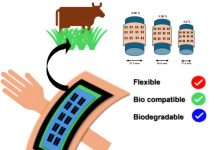
Imagine heating your home from the ceiling, not from underfloor heating or radiators.
Once installed like wallpaper, hi-tech infrared fabric emits heat in a similar way to the sun’s rays.
This could be a logical way to add low-carbon heat into existing homes that need retrofitting to improve energy efficiency.
Under the currently proposed legislative changes, no new home will be built with an incoming gas supply after 2025.
If you’re buying a new home that’s been designed and built to the new Future Homes Standard, you’ve got little to worry about.
But for older properties, retrofitting projects can be complex, inconvenient and expensive.
As gas boilers are phased out, heat pumps are usually the preferred alternative for energy-efficient housing. However, infrared fabric technology could be much better suited as a low-carbon heating solution for our existing housing stock, and here’s why.
- Instant heat
Unlike heat pumps, which are a slow response heating system, infrared fabric emits radiant heat that can be felt within minutes. That has multiple advantages.
Gas boilers heat up our rooms quickly so we don’t have to leave the heating on when we’re out, but heat pumps don’t work like that.
Instead, they deliver a continuous low level of heat, so homes need to be well-insulated to retain that heat and airtight to stop drafts. But, without drafts, we’ll need a mechanical ventilation system to circulate fresh air.
Instant radiant heat reduces the need for all these additional interventions by directly heating the people and surfaces in a room rather than the air itself.
It can be turned on or boosted to higher temperatures by motion sensors when you enter a room, with instant results. That means you only need to heat the rooms that you’re in, rather than an entire house.
- Simple to install
Infrared fabric looks like a roll of slightly stiff wallpaper.
It’s essentially a graphene sandwich, a thin film of carbon between two sheets of paper that conducts low voltage electricity and emits infrared heat, like the sun, but without the light or harmful ultraviolet.
A room’s ceiling area emits the right amount of heat for a room, making installation very simple in any property, irrespective of its construction, shape or size. It’s little more than a wallpapering job with a click together wiring connection.
Your gas boiler could even be left in place for emergencies alongside it. By comparison, heat pump installation requires extensive additional works and sometimes a period of relocation.
- Affordable heat
Infrared fabric is affordable to install and maintain due to its simplicity with a total cost of around £100 per sq meter for a full system.
And it’s quite indestructible—it can have holes cut out of it and can get wet in floods without any danger to occupants or damage to the material. It’s also affordable to run.
Heat pumps are known to generate more energy than they use, up to three times as much, by taking low grade heat out of the air and compressing it.
Infrared fabric can’t match that, but because radiant heat is instant, it’s only being emitted when needed in the rooms that you’re in, so even allowing for a hot water system the total energy use can be up to 20% less than from a heat pump.
Written by Michael Siebert/The Conversation.



